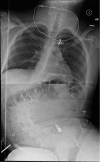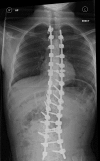The management of scoliosis in children with cerebral palsy: a review
- PMID: 28097247
- PMCID: PMC5233861
- DOI: 10.21037/jss.2016.09.05
The management of scoliosis in children with cerebral palsy: a review
Abstract
Children who suffer with cerebral palsy (CP) have a significant chance of developing scoliosis during their early years and adolescence. The behavior of this scoliosis is closely associated with the severity of the CP disability and unlike idiopathic scoliosis, it continues to progress beyond skeletal maturity. Conservative measures may slow the progression of the curve, however, surgery remains the only definitive management option. Advances in surgical technique over the last 50 years have provided methods to effectively treat the deformity while also reducing complication rates. The increased risk of surgical complications with these complex patients make decisions about treatment challenging, however with careful pre-operative optimization and post-operative care, surgery can offer a significant improvement in quality of life. This review discusses the development of scoliosis in CP patient, evaluates conservative and surgical treatment options and assesses post-operative outcome.
Keywords: Cerebral palsy (CP); child; scoliosis; spine; treatment outcome.
Conflict of interest statement
The authors have no conflicts of interest to declare.
Figures
References
Publication types
LinkOut - more resources
Full Text Sources
Other Literature Sources
Miscellaneous


